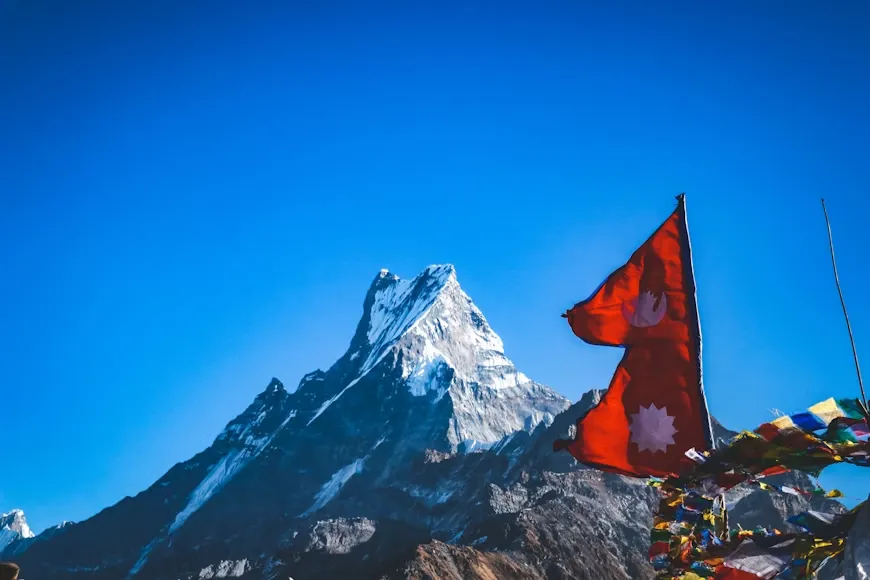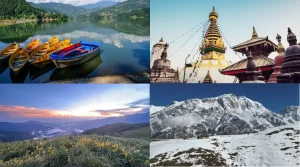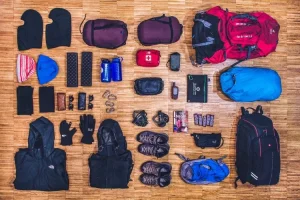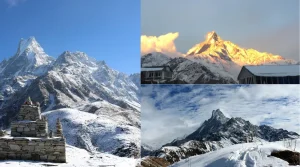Planning a trek to Mardi Himal? When you understand Mardi Himal weather patterns, you can enjoy a safe adventure. This hidden gem in Nepal’s Annapurna region offers beautiful mountain views. Weather conditions can impact your trekking experience.
Are you heading to the Mardi Himal base camp or aiming for the high camp? This guide covers everything you need to know about changes in seasons, temperature ranges, and the best times to visit. We’ll help you decode the Mardi Himal trek weather forecast. It will prepare you for whatever Mother Nature throws your way.
Why Mardi Himal Weather Matters for Your Trek?
Weather plays a decisive role in your Mardi Himal trekking experience. Unlike some lower-altitude treks, the weather in Mardi Himal base camp can change, affecting trail conditions.
The trek takes you from subtropical forests at lower elevations to alpine conditions above 4,000 meters. At Mardi Himal Base Camp (4,500m), temperatures can drop below freezing even in warmer months. This helps you pack and choose the best trekking window.
The stunning views of Annapurna South, Machhapuchhre (Fishtail), and Mardi Himal peaks can be seen in clear weather. These magnificent mountains leave you with limited visibility and dangerous trail conditions when the day is cloudy.
Best Seasons for Mardi Himal Trek
Spring (March to May): Paradise of Rhododendron
Spring offers some of the most spectacular Mardi Himal weather conditions. It makes the trail turn into a breathtaking journey of footsteps to heaven. March brings warmer days, cooler nights, and stable weather. The Mardi Himal base camp weather during spring features:
- Daytime temperatures can be 10-15°C (50-59°F)
- Nighttime temperatures can be 0-5°C (32-41°F)
- Morning skies are clear, with clouds in the afternoon
- Blooming rhododendrons create colorful landscapes
April and May come with warm spring features. The Mardi Himal high camp weather becomes more comfortable during this time, while the nights remain cold. These months offer excellent visibility for mountain photography, with rhododendron forests in full bloom along the trail.
The Mardi Himal trek weather forecast during spring shows stable high-pressure systems, making it ideal for multi-day treks. Occasional pre-monsoon showers may occur in late May.
Autumn (September to November): Peak Trekking Season
Autumn provides the most reliable weather patterns. After the monsoon comes crystal-clear skies and excellent mountain visibility. The weather of the Mardi Himal base camp during autumn includes:
- Daytime temperatures: 12-18°C (54-64°F)
- Nighttime temperatures: 2-8°C (36-46°F)
- Minimal precipitation/ rain
- Stable atmospheric conditions
September marks the transition from monsoon to dry season. Early September might still see occasional showers. Conditions stabilize by mid-month. Mardi Himal high camp weather in October brings clear skies and comfortable trekking temperatures.
November brings cooler conditions but maintains excellent visibility. The weather in Mardi Himal base camp remains pleasant during the day. Nights become colder as winter approaches.
Seasonal Weather Breakdown
Winter (December to February): Cold but Clear
Mardi Himal in Winter is about challenges and some rewards. Snow creates a winter wonderland in higher altitudes. The Mardi Himal base camp weather during winter features:
- December brings snowfall to higher elevations.
- Daytime temperatures at base camp range from 5-10°C (41-50°F), while high camp mardi himal weather can drop to -15°C (5°F) at night.
- January represents the coldest month. The Mardi Himal trek weather forecast shows stable but frigid conditions. Morning starts are particularly challenging, with frozen water sources and icy trails above 3,500 meters.
- February begins the gradual warming trend. The weather at Mardi Himal base camp starts improving, though Mardi Himal high camp weather remains harsh.
- Fewer trekkers and snow conditions for experienced winter trekkers can be observed.
Monsoon (June to August): Challenging Conditions
Monsoon season shows the most unpredictable Mardi Himal weather patterns. The weather in the base camp shows these patterns:
- This time brings heavy rainfall and high humidity
- Cloudy skies limit the mountain views
- Trails become slippery, muddy
- Leeches can be a problem below 3,000 meters
- Afternoon comes with thunderstorms
June marks monsoon onset with increasing rainfall. The Mardi Himal trek weather forecast shows unstable conditions with frequent weather changes. Trails become slippery, especially the steep sections above Deurali.
July and August are the peak monsoon time. Mardi Himal High Camp weather becomes cold and wet, with frequent cloud cover blocking the mountain views. However, the landscape becomes lush and green, offering a different experience for trekkers.
Weather Patterns at Key Trek Points

Forest Camp to Deurali (2,100m to 3,200m)
This elevation range experiences moderate mardi himal weather variations. The forest provides natural protection from wind and temperature extremes. You may expect:
- Temperature drops of 2-3°C per 500m elevation gain
- Higher humidity due to forest coverage
- Protection from direct sun exposure
- Occasional fog formation in valleys
Base Camp Conditions (3,300m)
The Mardi Himal base camp weather represents a transition zone between forest and alpine conditions. Weather becomes more unpredictable with:
- Stronger winds due to the exposed location
- Rapid temperature changes throughout the day
- Higher UV exposure requires sun protection
- Potential for afternoon cloud formation
High Camp Weather (4,500m)
Mardi Himal High Camp weather presents the most challenging conditions on the trek. This alpine environment features:
- Sub-zero temperatures most nights
- Strong winds, especially afternoon gusts
- Potential altitude-related weather sensitivity
- Rapid weather changes require constant monitoring
The high camp Mardi Himal weather can shift from sunny and calm to windy and cloudy within hours. Trekkers must prepare for all conditions and remain flexible with timing.
Essential Weather-Based Packing Guide
Spring and Autumn Packing
For optimal Mardi Himal weather conditions during peak seasons, pack:
- Base layers: moisture-wicking synthetic or merino wool
- Insulating layer: down or synthetic jacket for evenings
- Outer shell: waterproof, breathable jacket and pants
- Warm hat and sun hat
- Insulated sleeping bag rated to -10°C (14°F)
Winter Weather Gear
Winter weather in Mardi Himal base camp and higher elevations demands specialized equipment:
- Four-season sleeping bag rated to -20°C (-4°F)
- Insulated mountaineering boots
- Crampons or microspikes for icy sections
- Warm down mittens and liner gloves
- Face protection for wind and cold
Monsoon Adaptations
Monsoon weather forecast requires waterproofing everything, especially your electronics and the clothes you might need:
- High-quality rain jacket and pants
- Waterproof pack cover and dry bags
- Quick-dry clothing materials
- Extra socks and underwear
- Leech protection for lower elevations
Weather Safety Tips and Considerations

Monitoring Weather Conditions
Before you leave for the journey, check the Mardi Himal trek weather forecast from multiple sources. In your trip, consider:
- Take local weather insights from teahouse owners
- Use satellite-based forecasts compared to ground-based based
- Be careful in the late morning and early afternoons
- Start early to avoid weather problems
Altitude and Weather Interaction
Mardi Himal weather becomes more severe with elevation gain. The Mardi Himal high camp weather can be 15-20°C colder than base camp conditions. Understand that:
- Altitude multiplies the effects of cold exposure
- Wind speeds increase with elevation
- Weather changes happen faster at higher altitudes
- Hypothermia risk increases with elevation and weather exposure
Emergency Weather Protocols
Severe weather at Mardi Himal base camp or higher elevations may require emergency decisions:
- Make evacuation plans for dangerous weather
- Carry emergency communication devices
- Locate emergency shelters
- Remember, you matter more than the accomplishment
Planning Your Trek Around Weather Windows
Information about weather patterns in Mardi Nepal helps to optimize your trekking experience. The Mardi Himal base camp weather and conditions are changing year-round, offering a different experience for each season. Spring is all about blooming rhododendrons and warming temperatures, while autumn comes with the clearest mountain views. Winter offers solitude and pristine snow conditions for experienced trekkers, and the monsoon season transforms the landscape into a lush, green paradise despite challenging conditions like slippery trails.
The Mardi Himal trek weather forecast should guide your preparation, but flexibility remains key. Mountain weather can change rapidly, and the weather at Mardi Himal base camp and higher elevations may differ from valley forecasts.
Impact of Climate Change on Mardi Himal’s Weather

In recent years, climate change has also been causing a major impact on the Himalayas, including the Mardi Himal region. Unpredictable weather patterns, shorter snow seasons, and rising temperatures are becoming more common. These changes not only affect the trekking experience but also pose challenges to the local communities and fragile ecosystems that depend on stable weather conditions.
As mindful trekkers, we can contribute to preserving this beautiful environment by practicing sustainable tourism, minimizing waste, respecting local cultures, and supporting eco-friendly initiatives. Together, we can help protect the beauty of Mardi Himal for future generations.

Source: Meteoblue
Conclusion
Mastering weather knowledge in Mardi Nepal transforms your trek from a weather-dependent gamble into a well-planned adventure. Whether you’re monitoring weather in Mardi Himal base camp conditions or preparing for the challenging Mardi Himal high camp weather, understanding seasonal patterns helps you choose the optimal trekking window.
Remember that the weather adds both beauty and challenge to your Mardi Himal experience when you are in Nepal. Those stunning mountain views and diverse landscapes exist partly because of the varied mardi himal weather patterns throughout the year. Plan accordingly, pack appropriately, and stay flexible with your itinerary.
Ready to experience the magic of Mardi Himal? Check the Mardi Himal trek weather forecast, choose your season wisely, and prepare for an unforgettable Himalayan adventure. The mountains are waiting, and with proper weather preparation, you’ll be ready for whatever conditions await on the trail. Learn more about us and plan your trek today to make the most of your journey.
FAQs (Frequently Asked Questions)
1. What’s the most reliable weather season for Mardi Himal?
Autumn (October-November) offers the most stable mardi himal weather with clear skies and comfortable temperatures.
2. Can I trek during the monsoon season?
While possible, monsoon mardi himal weather presents significant challenges, including poor visibility, slippery trails, and limited mountain views.
3. How cold does it get at Mardi Himal High Camp?
High camp mardi himal weather can drop to -15°C (5°F) in winter and remains near freezing even in warmer months.
4. When should I avoid trekking in Mardi Himal?
Late monsoon (July-August) typically offers the most challenging weather in Mardi Himal base camp and higher elevations.
5. How many hours of walking per day in Mardi Trek?
You can expect to walk approximately 5 to 6 hours per day during the Mardi Himal Trek. The exact distance and duration depend on factors like trail conditions, elevation gain, and group pace. At Mardi Himal Treks and Expedition Pvt. Ltd., we craft itineraries tailored to your comfort, ensuring a personalized and enjoyable trekking experience.





